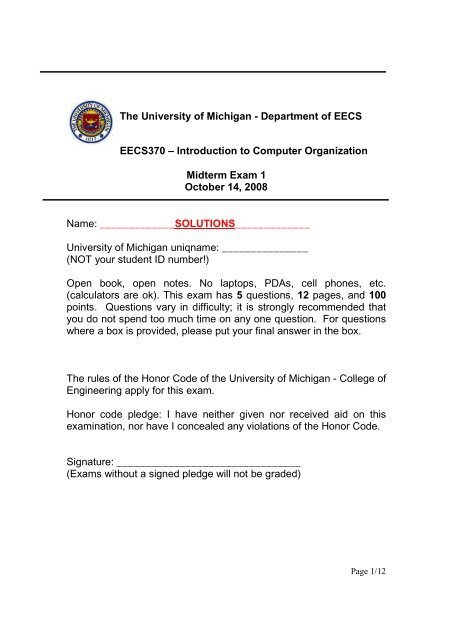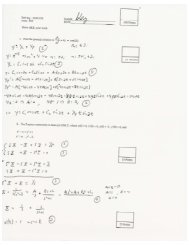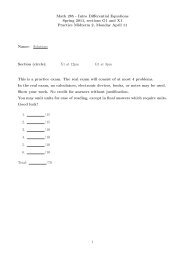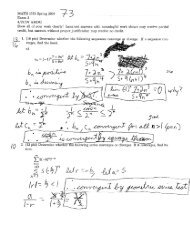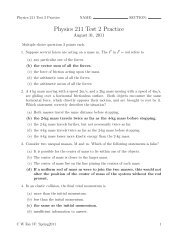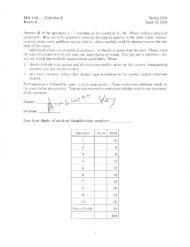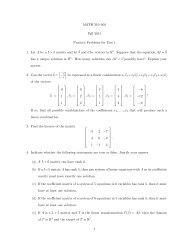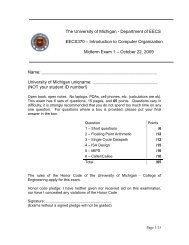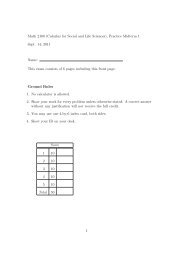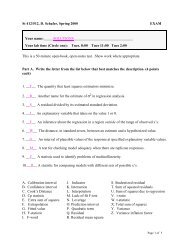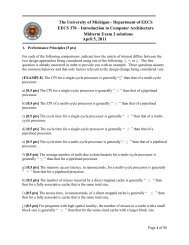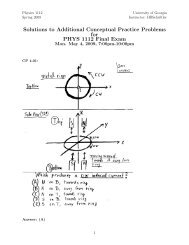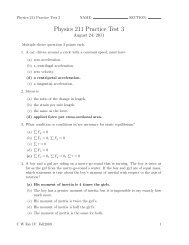Introduction to Computer Organization – Exam 1 w - We Tall Did ...
Introduction to Computer Organization – Exam 1 w - We Tall Did ...
Introduction to Computer Organization – Exam 1 w - We Tall Did ...
You also want an ePaper? Increase the reach of your titles
YUMPU automatically turns print PDFs into web optimized ePapers that Google loves.
1. Short and True/False Questions [32 points](a) [4 pts] Convert the following MIPS assembly instruction in<strong>to</strong> binary code:MOV $t1, $s2Write your answer in hexadecimal format here:Many possible answers <strong>–</strong> here are some examples:add $9,$18, 0 0x0240 4820and $9, $18, $18 0x0252 4824addi $9, $18, 0 0x2132 0000Note: it is not possible <strong>to</strong> use mov.s or mov.d, because floating point movecan only operate on floating point registers.(b) [5 pts] Consider the following C code snippet.void myalignfunct( int param){ //byte addresschar a; //0-0struct {//strb must be aligned as intshort b; //4-5struct { //stra must be aligned as intint c; //8-11char d; //12-12} stra; //13-15 padding} strb; //no padding neededdouble e; //16-23}… …Note: param is not a local variable.How many bytes does the allocation of the local variables in this code take in memory?Assume that the first variable can be allocated starting at address 0 and that the targetprocessor is a MIPS 32-bit architecture.24 BytesPage 2/12
(c) [3 pts] <strong>We</strong> have crafted an extremely compact floating point representation whichuses only 8 bits. The new representation works exactly as the IEEE floating point formatthat we studied in class. However, the bit allocation is as follows:- sign <strong>–</strong> 1 bit- exponent <strong>–</strong> 3 bits with bias 3- mantissa <strong>–</strong> 4 bitsWhich of the following is a base 10 representation of 1100 0000? Circle all correctanswers:Sign: - Exponent: 4-3 = 1 Mantissa: 1.0000 = 1 Answer: - 1x 2 1-192 -65 -12 -2 -0 2 12 65 192(d) [6 pts] The C function below is a recursive implementation of the “McCarthy91”function:int mccarthy(int n){int tmp;if (n>100) return (n-10);else {tmp = mccarthy(n+11);return mccarthy(tmp);}}This program is compiled and executed on a MIPS processor with input n = 98. What isthe maximum number of stack frames that can be found on the stack during thisexecution of the function? [Assume that the first stack frame is created with the call <strong>to</strong>mccarthy(98)]Stack his<strong>to</strong>ry:Level 1 Mc(98) Mc(98) Mc(98) Mc(98) Mc(98) Mc(98) Mc(98)Level 2 Mc(109) Mc(99) Mc(99) Mc(99) Mc(99) Mc(99)Level 3Mc(110) Mc(100) Mc(100) Mc(100)Level 4Mc(111) Mc(101)4 framesPage 3/12
(e) [3 pts] Indicate whether the following statement is True or False.Any caller-save register may be freely modified by the callee, even if it has notbeen saved by the caller.TrueFalse(f) [3 pts] Indicate whether the following statement is True or False.In the case of self-recursive calls, the callee-save registers do not need <strong>to</strong> be savedand res<strong>to</strong>red across function calls.TrueFalse(g) [2 pts] Consider the following C statement.printf(“the sum is %d <strong>–</strong> input %d\n”, sum, input);Where is the string “the sum is %d <strong>–</strong> input %d\n” s<strong>to</strong>red? Circle all correctanswers.heap stack global segment text segment(see an example in slide 29 <strong>–</strong> lecture 4)Page 4/12
2. LC-2K Assembly [18 points]Consider the following LC-2K assembly program.0 lw 0 1 foo1 lw 0 2 n2 lw 0 3 neg13 lw 0 4 stAdd4 start beq 0 2 end5 add 1 1 16 add 2 3 27 here jalr 4 58 sw 0 1 baz9 halt10 end jalr 5 611 foo .fill 112 n .fill 413 neg1 .fill -114 stAdd .fill start15 baz .fill 0(a) [5 pts] List the PC values of the first 10 instructions <strong>to</strong> be executed in the program,assuming that the program is s<strong>to</strong>red starting at location 0.PC:0 1 2 3 4 5 6 7 4 5(b) [5 pts] How many times is the line labeled here executed during execution of thiscode?4timesPage 5/12
(c) [4 pts] What value is in memory address 15 when this code is done executing?Answer:16(d) [4 pts] Provide a brief one or two sentence explanation of what the code is doing.Mem[15] = foo*2 n for n > 0For full credit, you only need <strong>to</strong> say that the code computes 2 n .Page 6/12
3. Memory Addressing [12 points]Consider the following MIPS assembly program:0: lui $1, 11: addi $1, $1, -22: sh $1, 0($2)3: lb $2, 1($2)4: add $2, $1, $25: lhu $1, 1002($0)Recall that Register $0 always contains the value zero. The memory is organized in bigendianformat, the same format we studied in class. Fill in the following tables based onthe instruction sequence above. When a register or memory location does not changewrite a dash (--) in the corresponding space of the table.The initial value for Register $1 is 0x0000AAAA and for Register $2 is 0x00001000.Reg After inst 0 After inst 1 After inst 2 After inst 3 After inst 4 After inst 5$10x000100000x0000FFFE$2 -- -- ---- -- --0xFFFFFFFE0x0000FFFC0x00002680--MemoryAddressInitialvalueAfter inst0After inst1After inst2After inst3After inst4After inst51000 10 0xFF -- -- 0xFF -- -- --1001 10 0x11 -- -- 0xFE -- -- --1002 10 0x26 -- -- -- -- -- --1003 10 0x80 -- -- -- -- -- --Page 7/12
(a) [4 pts] Encode the following assembly instructions.Instructionload -4alu.multhaltHexadecimal1011 1100 = 0xBC1110 0010 = 0xE20110 0000 = 0x60(b) [5 pts] The load instruction uses “base + displacement” memory addressing mode.You are asked <strong>to</strong> design a new pseudo-instruction loadd, which uses a “direct” memoryaddressing mode. The memory address for loadd is specified using the 5-bit IMM field.(i) What is the range of values that the immediate field (IMM) can encode for theload instruction?Answer:-16 15<strong>to</strong>[min value][max value]The IMM field for load uses 2’s complement notation <strong>to</strong> encode the offset.(ii) What is the range of values that the immediate field (IMM) can encode for thenew loadd pseudo-instruction?Answer:0 31<strong>to</strong>[min value][max value]Only positive numbers make sense for direct memory addressing, so loadduses unsigned notation <strong>to</strong> encode the address.(c) [5 pts] Assembly programmers request also that you add a “dupe” pseudo-instruction,which pops the <strong>to</strong>p value from the stack and pushes it back on<strong>to</strong> the stack twice. TheISA reserves memory location 0 for pseudo-instruction temporary use. Write theassembly code for this pseudo-instruction using as few instructions as possible. Note:you may use the loadd pseudo-instruction of part (b). Write your code *neatly* below:pushi 0s<strong>to</strong>re 0loadd 0loadd 0Page 9/12
(d) [5 pts] Reorder the scrambled assembly instructions provided below <strong>to</strong> perform thefollowing computation:// compute the absolute value of x (2’s complement)if (x < 0) result = <strong>–</strong>x;else result = x;Assume x is initially s<strong>to</strong>red at the <strong>to</strong>p of the stack. For full credit, clearly write thereordered instructions in the boxes provided on the right-hand side (no drawing arrows orthe line numbers of the instructions).haltpushi -1pushi 1pushi 7alu.addalu.slralu.xorbeqz 4dupedupepushi 7alu.slrbeqz 4pushi -1alu.xorpushi 1alu.addhalt(e) [3 pts] A new intern’s summer task is <strong>to</strong> design a new TurboALU that can performmore ALUOPs than the current ALU in StackAttack (such as “not”, “shift rightarthimetic” and “divide”). He comes <strong>to</strong> you <strong>to</strong> ask how many additional ALUOPs canbe added <strong>to</strong> the current ISA. What is your answer?There are two unused bits for A-type instructions, so the ALUOP field can beexpanded from 3 bits <strong>to</strong> 5 bits.2 5 possible <strong>–</strong> 2 3 existing = 32 <strong>–</strong> 8 = 24 additional ALUOPs.Answer:24Page 10/12
5. Single-Cycle Datapath [14 points]Figure 1: Single-cycle datapath from Lectures 9 and 10Consider the single-cycle datapath shown in the figure above. (This is the datapathcovered in Lectures 9 and 10). <strong>We</strong> want <strong>to</strong> introduce the instructioncondi_add rs1 rs2 rdIn this instruction, the opcode is s<strong>to</strong>red in bits 24-22, rs1 is s<strong>to</strong>red in bits 21-19, rs2 iss<strong>to</strong>red in bits 18-16, and rd is s<strong>to</strong>red in bits 2-0. The following pseudo-code describeshow the instruction operates (Note:[rs]denotes the contents of register rs):if [rs1] == [rs2]then [rd] [rs1] + [rs2]Page 11/12
(a) [4 pts] List all the new hardware components (e.g., adders, ALUs, MUXs, registers,register files, memories, constants, etc.) that must be introduced <strong>to</strong> support condi_add.List type and quantity for each component you add in the table below:Component typeMUX 1quantity(b) [5 pts] Using Figure 1, show where in the datapath your new hardware from part (a)is introduced. Make sure you clearly indicate any new wires that are introduced or thatneed <strong>to</strong> be re-routed.See Figure 1(c) [5 pts] List any new control signals that must be introduced <strong>to</strong> implement thisinstruction and indicate which components they control. For the various instructions inthe LC-2K ISA, give the values provided by the control ROM for these signals.New control signal - nameControlled componentValue <strong>to</strong> use forcondi_addctl MUX 1 0Value for otherinstructionsPage 12/12


